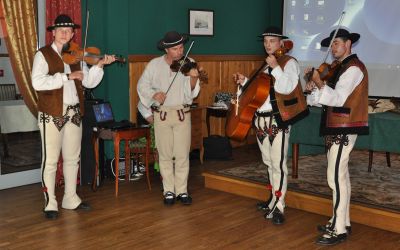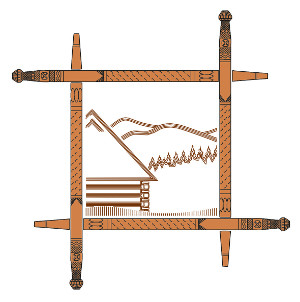
Most of the pastoral elements have been preserved in the culture and costumes of the inhabitants of the highest parts of our mountains, i.e. the Bieszczady Mountains. Wherever there were convenient, extensive dry grazing meadows - mountain pastures. The higher, the greater was the share of breeding in the farm, and thus shepherding. The lower, the more agricultural activities dominated, and pastoralism played a complementary role. This can be clearly seen in costumes and customs. The lower the terrain, the more the profession of the shepherds and yuhas disappears. The higher, the more sheep's wool is visible in outfits, especially the light ones.
A characteristic element for mountain shepherds is a ciupaga, bartka, sokyra, sokyrka, topirec, kełef /types of traditional weapons/. It is a relic of ancient times of medieval origins, when every juhas had to be a warrior at the same time. It was necessary to protect their herds not only against wild animals, but also against various kinds of thieves and robbers. It was therefore a lightweight, handy and universal weapon. With time, the attribute of a juhas and shepherd. It took various shapes, the most popular of which is the form of an axe - a relic of an old combat axe. The relic of a medieval tschekan is the famous Hutsul kołef. Another characteristic element of the shepherd's and highlander's costume is a wide belt (shepherd's belt, trzos, čéres). It used to be a medieval semi-armored armour, protecting the soft peritoneal organs not only from the blow of knife, jatagan, fist or leg, but also from kicking with the hoof or hitting with the horn of the animal. It also supported the trunk during the efforts to prevent the hernia. It also served as a handy storage for the most necessary things and a representative function.
The next element of the outfit is the headgear. The most famous is the hat ((kapeluch, klopuk, kłobuk, krysania etc.) Hats worn by Carpathian highlanders have evolved over the centuries, depending on the fashions and available materials or workshops of their products. It also depended on the property of their owners. The most popular and oldest were simple hats made of felt, using special patterns. Usually they did not have (or had a poorly distinguished) separate orifice. Over time, the orifice grows, leaning downwards, upwards or remaining straight. A hat with a slightly inclined orifice is popular in Podhale. However, the one with a simple orifice is called a Hutsul "krysania". A larger brim of the hat protected not only the head, but also the neck and shoulders from the sun and rain. In the Lemko and Boyko regions hats with a raised orifice, often called Uhorskie, or Hungarian hats, were very popular. In the Boyko region it was also called "hałamućkyj kapeluch". Hats with more or less raised orifice (sometimes even vertical) became popular in the nineteenth century, especially near the Hungarian border. Highlanders from the Bieszczady and Low Beskids often went to the so-called "Hungarian side". They wandered south, especially during the hay and harvest period, which, due to the warmer climate, started about 3 weeks earlier than in their native regions. Returning home, they did shopping in Hungarian cities, bringing new fashions to their homeland. After the harvest, they also travelled south to be hired for working in vineyards . In addition to hats, other necessary and inaccessible things were purchased in the former Kingdom of Hungary. Buttons, materials, metal products, men's and women's accessories, shoes (Hungarian shoes), etc. were also bought in the former Kingdom of Hungary. In summer men wore straw hats, in winter high hats, sheep's hats - kuczmy or lamb's hats (caps) covered with broadcloth. In the foothills, woolen caps called magierki were also worn. Girls would walk without covering their heads, but decorating them with ribbons, wreath or selvedge. The hair was braided. When a girl got married and became a woman, walking with her head uncovered was no longer an option. She had to wear a cap (oczipok), under which her hair was braided on a homełka (hymla) /a circle made of a wooden bar or wire/. Homełka was made of hazel, apple or wire. Women wore a scarf on their heads (Lemkoschyna - facełyk, a linen or woolen scarf covering their shoulders).
Another, no less interesting element of the costume of the highlanders from the Eastern Beskids were shoes. They were the most important determinant of the status of their owner. It was common to walk barefoot if the weather conditions were appropriate for it. Children, in particular, rarely used shoes. Handmade leather shoes are usually Kierpce (kerpci, eastern Lemkosszczyzna and western Boyko region - clogs, Boyko region and Hucul region - postoły). They differed mainly in the way of "collecting" and joining the leather on the fingers. The more to the east, the more they had a raised tip. They were tied with a woolen rope or thong. The richer gazdas wore leather, high shoes: the so-called "Polish" with a rigid upper part, the "Russian" with a soft upper part, or the "Hungarian" ones imitating the shoes of hussars. There were also Russian sapoga (saphy). Rich female gazdas wore booties or high boots. The poor wore linden saboty (clogs, derewjanyky, dowbanky). There were also shoes made of straw, with a wooden sole (słomianyky).
The feet were wrapped in footwraps called onuce (in winter also with straw). At the beginning of the 20th century woolen socks were made.
Men wore linen trousers in the summer - nohałky, portky, gaci - and woolen chołosznie in the winter. They were usually decorated with colourful stripes and trimmings. Sometimes the openings were ornamentally hemmed. Chołosznie with two flies or with one placed on the side were common. Since there were no zips and the buttons were very expensive, 2 flies (or 1 slightly on the side) allowed the unfold the coattail of the chołosznia if it was necessary.
A leather belt or string going through the belt loops and flaps of the fly supported the trousers.
Women in the Eastern Lemkivshchyna wore colourful, coloured skirts (kabaty, farbanky, wybijky – the older skirts were white and decorated only with sewn-in colourful ribbons) and an apron, sometimes referred to as a waistband, which refers to another, older form of women's clothing.
Under the apron, in the skirt, there was a "podiłok" made of plain linen, which allowed for widening or narrowing the skirt without the need to redo it.
Men's outer clothing was hunia, kurtak or sirak (in the Boyko region) in Lemkos, while a characteristic canvas of czuhania (czuha) with a collar long almost to the belt.
Lejbyk was put on the shirt, in Boykos it was much longer than in Lemkos. In Boykos it was usually dark brown whereas it was blue in Lemkos. Lejbyki were made of woolen cloth.
In the Western Lemkivshchyna, as well as in the eastern Lemkivshchyna and the Boyko region, in villages located closer to urban centres, female lejbyki were replaced by corsets coming along with urban and court fashion.
Successively, the archaic geometric embroidery was replaced by fashionable and popular court and city patterns - mainly floral ones.
The shirt (giezło) in our mountains was called "soroczka". It had a finely pleated transition into cuffs and collar edges. Cuffs, collar rims and very often breast pockets were embroidered ( there were more of them in the east).














